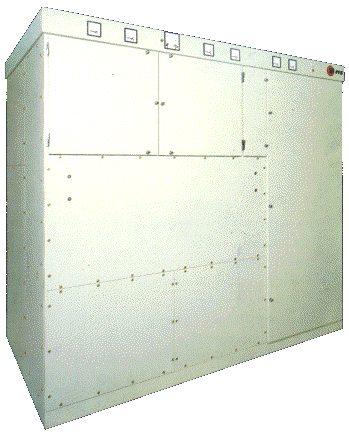| GENERAL DESCRIPTION |
 20 kW Short Wave Broadcasting / Communication Transmitter type OR 20 K-01/A is a member of the RIZ's new generation of automatic tunable, amplitude modulated transmitter, capable to operate at any frequency within the SW frequency band between 3.2 and 18 MHz, output power up to 20 kW.
20 kW Short Wave Broadcasting / Communication Transmitter type OR 20 K-01/A is a member of the RIZ's new generation of automatic tunable, amplitude modulated transmitter, capable to operate at any frequency within the SW frequency band between 3.2 and 18 MHz, output power up to 20 kW.| TECHNICAL SPECIFICATIONS | |
| OPERATING CONDITIONS | |
| Power Supply | |
| Mains voltage | 3 x 380V / 220V, +5%, -10% |
| Power consumption (fm=1kHz/m=1) | 56 kVA |
| Mains frequency | 50 Hz ±2Hz, or 60 Hz as option |
| Power factor | cos phi greater than 0,9 |
| Modulator Input | |
| Input impedance (from 60 to 7500 Hz) | 2000 Ohms balanced standard, 600 Ohms balanced, as option |
| Input level (for fm=1 kHz, m=1) (0 dBm=0.775V across 600 Ohms) |
-6 to +12 dBm |
| Transmitter Output | |
| RF output load impedance | 50 Ohms unbalanced |
| Permissible VSWR | s less than 2 |
| Climatic Conditions | |
| Temperature in transmitter hall | +5 to +45 C |
| Max. altitude above sea level | 2300 m |
| Relative humidity | less than 90% |
| ELECTRICAL CHARACTERISTICS | |
| RF Output Power | |
| Carrier power in the range 3.2 to 26.1 MHz | 20 kW A1, 20 kW PEP SSB |
| Frequency range | 3.2 to 18 MHz |
| Frequency stability | 2 x 10-7 per day |
| Modulation principle | Polyphase Pulse Duration Modulation |
| Type of emission | AM, CW, SSB (with 6 dB / 12 dB carrier reduction below PEP), ISB (optional), F1 (optional), F6 (optional) |
| Modulation Characteristics | |
| The ratio of input to output as function of modulation depth up to m=80% does not differ by more than | ±0.5 dB |
| Intermodulation Distortion | 35 dB relative to either of two equal test tones at full PEP |
| Signal to Noise Ratio | |
| Unweighted | more than 50 dB |
| Weighted | more than 55 dB Reference level m=100% fm=1 kHz,sinusoidal Mains voltage sinusoidal |
| Harmonic and Spurious Emission | |
| Harmonic and Spurious Emission | more than 56 dB |
| Carrier Shift | |
| Carrier shift at m=90% with fm=1 kHz sinusoidal and at a constant mains voltage referred to the unmodulated carrier |
less than 4% |
| Overall Efficiency | |
| Overall efficiency | more than 60% (fm=1kHz, sinusoidal) |
| Specifications may change without notice | |
| TUBE COMPLEMENT | |||
| RF stages | AF stages and modulator | ||
| Number | Type | Number | Type |
| 1 | 4CX20,000B | ||
| THIS TYPE OF TRANSMITTER IS INSTALLED IN THE FOLLOWING COUNTRIES | |||||
| ITU | Country | ITU | Country | ||